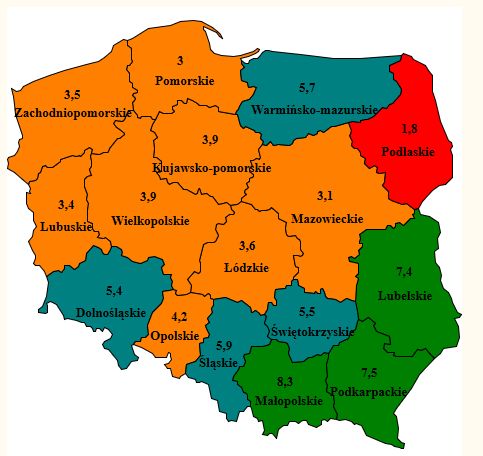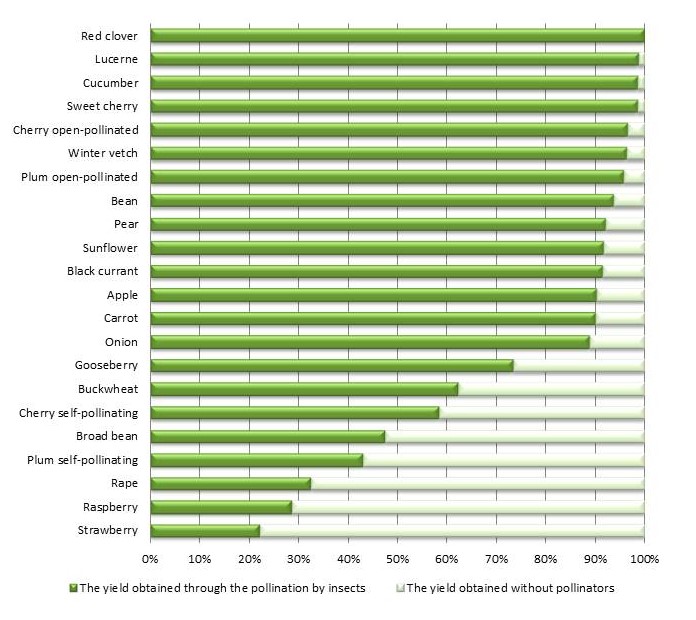

Utilisation of the Red Mason Bee in Orchards and Other Crops
Influence of pollination on yield of plants is obvious. Vast majority of orchard plants and many other agricultural plants need to be pollinated by bees in order to give satisfactory amounts of fruit and seed.
Pollination is a process of transferring pollen grains (male reproductive cells) from anthers to pistil stigma. The pollen grain sticks to the stigma and creates pollen tube growing through the style into the ovary. Inside the ovary pollen's generative nucleus merges with the egg cell (female reproductive cell) creating the zygote (fertilisation). Consecutive cell divisions result in creating a seed. Fertilisation triggers off production of hormones that stimulate growth of the flower cup which results in the creation of fruit (to keep it very short and simple :-)).
Bees, meaning not only the honey bee but entire Apidae family that is about 450 species in Poland, are main pollinators in moderate climate. The honeybee pollinating over 90% of flowers is the main pollinator but we cannot underestimate the role of other bees such as bumble bees or solitary bees. In Poland, according to the 'Beekeeping Sector Analysis' prepared every year by Piotr Semkiw, PhD of the Research Institute of Horticulture, Apiculture Division in Puławy, Poland, we have about 1.4 million bee colonies, however, the number of bees per 1 km2 differs between regions of Poland (a map). The worst situation is in the Podlaskie, Mazowieckie and Pomorskie Voivodeships. The highest number of bee colonies per 1 km2 have the Lubuskie, Podkarpackie and Małopolskie Voivodeships.

Shortage of bees in the Mazowieckie Voivodeship is especially alarming as this region leads in the area of orchards and in fruit production. In details, the average for the Grójec County (3774 colonies in 201 apiaries/1269 km2), is 3 colonies per 1 km2 (0.03 colonies/1 ha). Assuming the required 3 colonies per 1 ha of orchards means that this county needs 100 times more colonies (!!!). Situation in the Sandomierz County, equally important in fruit production, is no better. Here in 1 km2 we can find 3.5 colonies (0.035 colonies1 ha !!!) while the average for the Świętokrzyskie Voivodeship is 5.5 colonies/1 km2. This data concern entire areas of counties, however, they prove high shortages of pollinators in our cultivations.
Keeping honey bees is quite difficult and requires a lot of knowledge, experience and work and the extent of renting bee colonies for orchard pollination is little. That is why more and more orchard owners being aware of insufficient pollination of their crops decide to use the red mason bee. Thus, the red mason bee became very important supplementary and very often main pollinator of orchards thanks to its easy breeding, satisfactory population increase and high pollination efficiency.
Precise, optimal number of cocoons per 1 ha of crops is not known because studies conducted in isolation are not very reliable and field experiments are impossible to conduct due to presence of honey bees and other insects. However, based on theoretical calculations and field observations it can be assumed that good pollination of 1 ha of apple orchard requires 1000 of red mason bee cocoons. In the case of cherries and sweet cherries the number of cocoons should be 2 or 3 times higher due to more abundant blooming. Nevertheless, even smaller number of insects introduced into an orchard will result in increased yield and improved quality of crops.
The below graph shows the influence of pollination on fruit and seed yield of some plants. In vast majority of cases yield increase is obvious. Raspberry and strawberry presented at the bottom of the graph seem to have little demand for pollinators but the yield obtained without them, lower by 25-30%, is of much worse quality. These fruits can be used only as a cheap raw material for the processing industry and cannot be sold as dessert fruit that are more expensive.

In addition to orchards, red mason bees are successfully used in other agricultural cultivations and in field and greenhouse vegetable cultivations.
The red mason bee, like all the wild bees, has short flight distance of up to 300 m from the colony. This means that colonies need to be arranged in a way enabling the ranges to cover the entire area of cultivation that is in about 200-m intervals. It is especially important in orchards in a shape of elongated rectangles.
Additionally, this bee visits anemophilous plants very willingly. It is probably due to the high pollen production of these plant species (oak, beech, hornbeam, elm, maple and walnut). Thus, to be sure that our red mason bees do not forage on competitive plants and stay in the orchard we should place colonies about 200 meters from those plants.
Red mason bee colonies should be left in place until September because also after females cease flying, larvae still feed on pollen and metamorphose and they should not be shaken at that time. If the nest box interrupts plant protection treatments and fruit collection, it needs to be gently moved in a safe place but not trucked.
Chemical plant protection treatments can be done only keeping the safety periods for bees (safe re-entrance of bees) and with highest safety measures. During sprayings at night the nest boxes need to be covered with plastic bags so that the solution does not get into the colony. Afterwards, bags need to be removed.
You will find additional information in the 'Overwintering' section.
Dariusz Teper